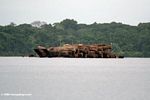The forestry sector in the Democratic Republic of Congo (DRC) is completely out of control, according to a new eye-opening report. Put together by the Chatham House, the report estimates that at least 87 percent of logging in the DRC was illegal in 2011, making the DRC possibly the most high-risk country in the world for purchasing legal wood products.
The DRC contains Africa’s largest expanse of tropical forests, including the bulk of the Congo Rainforest. As such it is home to a number of species found nowhere else, including the okapi (Okapia johnstoni) and bonobo (Pan paniscus) among many others. The country also houses a number of indigenous forest tribes, many of whom have struggled against illegal logging.
“Although the [DRC’s] deforestation rate is relatively low compared with that of many other tropical countries, it is among the highest in the Congo Basin and is rising,” reads the report, adding that “only around 10 percent of the DRC’s forests are currently designated for logging and official log production remains low in relation to the area of forest.”

Logging truck in the DRC. Photo by: © Thomas Einberger/argum/Greenpeace.
But illegal logging is booming: actual log harvests are currently eight times higher than the government’s official data. The major problem, according to the report, is poor governance.
“DRC is a huge place, and is extremely impoverished and anarchic following years of kleptocracy and conflict,” author of the report Sam Lawson told mongabay.com. “In a poor country with little in the way of industry, illegal logging is also a tempting way for companies and corrupt officials to make money.”
Lawson also points to a growing domestic market for wood in the DRC. According to the report, harvests for domestic use have doubled in the last six years.
“The growing populations in DRC’s major cities also play a part: demand for timber for local use is rapidly rising, and there is limited ‘legal’ supply,” noted Lawson.
The DRC’s population is currently growing at a steady clip of 2.86 percent annually according to the CIA with the urban population growing at 4.19 percent in part due to migration from the country to the city.
However, there is still time to protect the bulk of DRC’s forests.
.600.jpg)
Bonobo in zoo in France. The bonobo, one of seven great apes, are only found in the DRC. The country is also home to chimpanzees and gorillas. Photo by: Hans Hillewaert/Creative Commons 3.0.
“Unlike some other tropical forest countries, there is still a lot of valuable forest worth saving, and the pace at which what remains is being degraded and destroyed is still sufficiently slow,” reads the report.
To get the situation under control, the Chatham House report recommends that the DRC drastically improve transparency, increase enforcement efforts, and maintain the moratorium on new licenses for industrial logging. Finally, the DRC needs to deal with its smallscale logging.
“It must also be recognized that the majority of harvesting in the DRC is currently illegal artisanal logging for domestic and regional markets. It is important that steps are taken to bring this large industry under formal control,” the report reads.
 Okapi in Miami Zoo. Photo by: Nancy Heise/Public Domain. |
Despite the massive epidemic of illegal logging in the DRC, Lawson says “one bright spot” are the recent laws in the U.S., Europe, and Australia that criminalize importing illegally harvested wood from abroad.
“This is helping to encourage the [DRC] government and the logging companies to begin moving in the right direction,” said Lawson. “The EU is also actively engaged in DRC in trying to improve forest governance, supporting civil society and independent monitoring and negotiating with the government.”
Lawson notes that any wood imported from the DRC must be considered suspect, a fact highlighted by the recent confiscation of DRC-logged wenge wood in Germany.
“[Importers] don’t just need to be careful about direct purchases,” added Lawson, “they also need to be careful about buying wood products from places like China, which import large volumes from these countries and others affected by illegal logging.”
Worldwide illegal logging is worth $30-$100 billion in ill-gotten gains, according to a 2012 report by INTERPOL and the United Nations Environment Programme (UNEP). It is also responsible for 15-30 of total forest loss in the tropics. The practice not only harms local communities, threatens biodiversity, and worsens climate change, but also results in lost revenue for often poorer governments. Conflict between illegal loggers and forest communities often results in violence and sometimes murder.
“When the forests are destroyed or degraded by illegal logging, livelihoods are damaged or destroyed,” said Lawson. “Illegal logging also fuels corruption and conflict, preventing the country as a whole from developing. The poor stay poor as a result.”

View of Congo River from Maluku, DRC. Photo by: Public Domain.
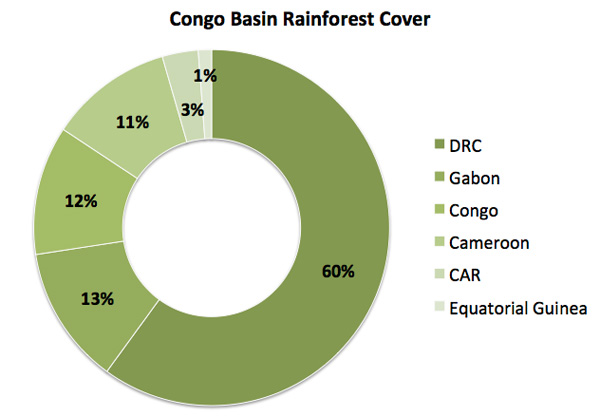
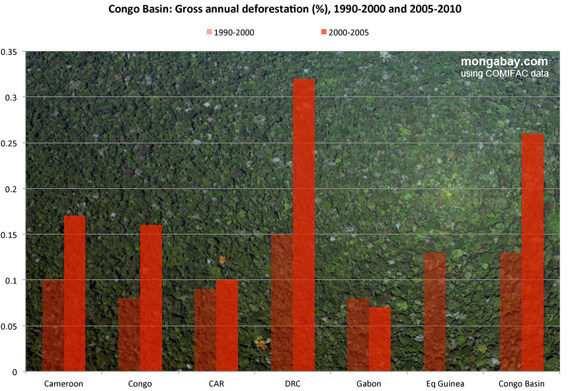
Deforestation in the Congo Basin. Click image to enlarge.
Related articles
Europe not doing enough to stop illegal logging imports says Greenpeace
(03/04/2014) Europe is failing to fully enforce its one-year-old EU Timber Regulation (EUTR), alleges Greenpeace, with illegally-logged wood still slipping into the continent, especially from the Democratic Republic of Congo (DRC).
Bonobos: the Congo Basin’s great gardeners
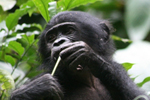
(12/11/2013) The survival of primary forests depends on many overlapping interactions. Among these interactions include tropical gardeners, like the bonobo (Pan pansicus) in the Congo Basin, according to a new study in the Journal of Tropical Ecology. Bonobos are known as a keystone species, vital to the diversification and existence of their forests.
Sky islands: exploring East Africa’s last frontier
,-South-Pare-Mts.-Tanzania.150.jpg)
(12/04/2013) The montane rainforests of East Africa are little-known to the global public. The Amazon and Congo loom much larger in our minds, while the savannas of East Africa remain the iconic ecosystems for the region. However these ancient, biodiverse forests—sitting on the tops of mountains rising from the African savanna—are home to some remarkable species, many found only in a single forest. A team of international scientists—Michele Menegon, Fabio Pupin, and Simon Loader—have made it their mission to document the little-known reptiles and amphibians in these so-called sky islands, many of which are highly imperiled.
28 percent of potential bonobo habitat remains suitable

(11/27/2013) Only 27.5 percent of potential bonobo habitat is still suitable for the African great ape, according to the most comprehensive study of species’ range yet appearing in Biodiversity Conservation. ‘Bonobos are only found in lowland rainforest south of the sweeping arch of the Congo River, west of the Lualaba River, and north of the Kasai River,’ lead author Jena Hickey with Cornell told mongabay.com. ‘Our model identified 28 percent of that range as suitable for bonobos. This species of ape could use much more of its range if it weren’t for the habitat loss and forest fragmentation that gives poachers easier access to illegally hunt bonobos.’
Elusive giraffe-relative – the okapi – now listed as Endangered
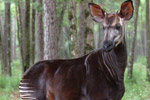
(11/26/2013) The discovery of the okapi shocked the world in 1901. African explorer, Henry Stanley, called it ‘donkey-like,’ while others thought it a new species of zebra, given the stripes. However, this notoriously-secretive rainforest ungulate proved to be the world’s only living relative of the giraffe, making it one of most incredible taxonomic discoveries of the Twentieth Century as well as one of the last large-bodied mammals to be uncovered by scientists. But the future of the okapi (Okapia johnstoni) is increasingly in doubt: a new update of the IUCN Red List released today has raised the threatened level for the okapi from Vulnerable to Endangered.
A year after devastating attack, security returns to the Okapi Wildlife Reserve (photos)
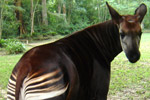
(09/09/2013) On June 24th of last year, MaiMai Simba rebels, led by an elephant poacher known as Morgan, launched a devastating attack on the headquarters of the Okapi Wildlife Reserve in Epulu, Democratic Republic of Congo (DRC). The attack, which was reportedly in response to a crack down on poaching and illegal mining in the park, left buildings burned, equipment destroyed, and six people dead including two rangers. The militia also left with 28 women hostages, many of them minors. As if to add insult to injury, the militia didn’t leave until they shot dead all 14 captive okapis at the headquarters, which were used as wildlife ambassadors for the local community.
Meet Thor’s shrew: scientists discover new mammal with a superior spine
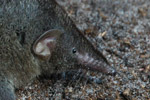
(07/30/2013) In 1917, Joel Asaph Allen examined an innocuous species of shrew from the Congo Basin and made a remarkable discovery: the shrew’s spine was unlike any seen before. Interlocking lumbar vertebrae made the species’ spine four times strong than any other vertebrate on Earth adjusted for its size. The small mammal had been discovered only seven years before and was dubbed the hero shrew (Scutisorex somereni), after the name give to it by the local Mangbetu people, who had long known of the shrew’s remarkable abilities.
NGO hits out at study for downplaying logging threat in Congo rainforest
(07/23/2013) Global Witness has called in question conclusions reached in a study on logging in the Congo rainforest. The group, which has published a series of investigative reports on abuses by logging companies operating the world’s second largest tropical forest, said that a review published Monday in the Philosophical Transactions of the Royal Society B ‘[presents] a misleading and inaccurate picture of the present and growing threats to the Congo Basin rainforest.’
Deforestation rate falls in Congo Basin countries

(07/22/2013) Deforestation has fallen in Congo Basin countries over the past decade despite a sharp increase in the rate of forest clearing in the Democratic Republic of the Congo, according to a new study published in the Philosophical Transactions of the Royal Society B as part of a set of 18 papers on the region’s tropical forests. The special issue, which was put together by Oxford University’s Yadvinder Malhi, covers a range of issues relating to the rainforests of the Congo Basin, including deforestation, the impacts of global change, the history and key characteristics of the region’s forests, and resource extraction, among others.
